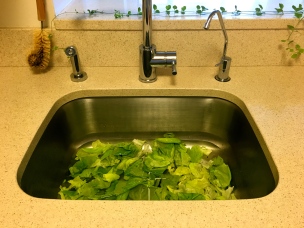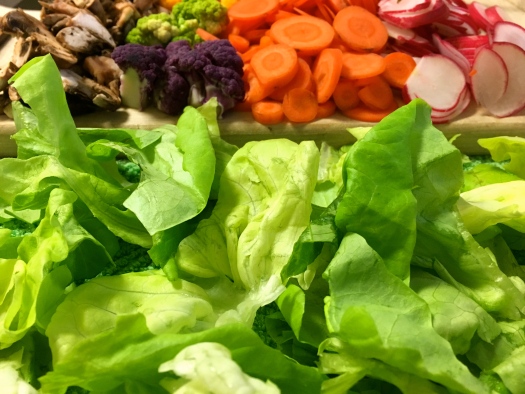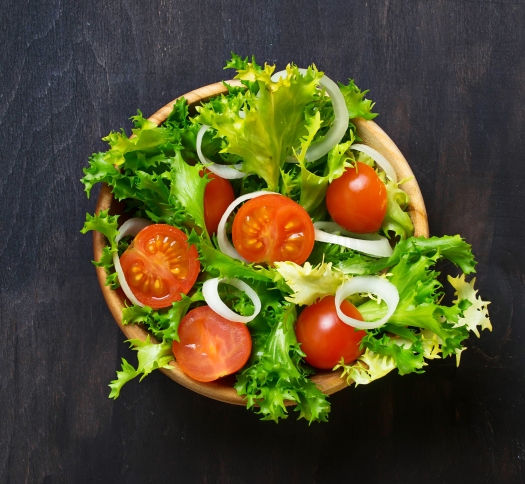
We’ve all been there… We have the best of intentions as we purchase a bundle of gorgeous fresh veggies thinking pleasantly to ourselves that we’ll eat salad every day this week. Several days go by where the thought of rinsing, chopping and preparing a salad is too much fuss and then you end up with a soggy head of lettuce at the bottom of your fridge and those crisp carrots a little on the soft side. Now, not only have deprived your body of all those healthy nutrients you’d intended to eat, but you’ve wasted money and contributed to the major environmental issue of food waste.
But, there’s a solution! It takes a little discipline when those veggies first arrive in your kitchen, but the reward is well worth the initial input of effort. You will be able to throw together healthy, fresh meals and snacks in literally minutes throughout the week when you’re busy.
The answer is to clean, chop and store all those veggies when you first buy them (not three days later). Of course, you can purchase pre-washed and chopped veggies and in a real pinch I think this is a great alternative to not eating any salad or vegetables for the week. I have certainly made the seemingly extravagant purchase of prepared vegetables and greens. The problem with those conveniently packaged veggies is of course the plastic and huge price tag. Also, the methods below will actually keep your veggies fresh longer than the plastic containers. So if you’ve got an hour on a Sunday, you can save yourself a lot of cash, and be much kinder to the planet!
Bonus: If at the end of the week you still have some leftovers you can make a stir-fry or soup.
Part 1: Greens
- Rinse your greens by filling up a clean sink with cold water, shredding the greens into bite size pieces with your hands and swirling the greens in the sink. (Bonus: you’re required to give your sink a good scrub first, thereby getting two household chores out of the way.) If the water looks dirty, scoop out the greens, drain the water and repeat the process until the water looks clean.

- Place the greens into a salad spinner and spin until most of the water comes off, but the leaves are still damp.
- Lay the leaves out evenly on a clean dish towel. Allow the greens to air dry for at least 30 minutes. You can move onto the other steps during this wait time. Dish towels work better than paper towels at keeping greens fresh and are better for the environment.
- Roll up the greens in the dish towel and tie up with rubber bands or string. Store in the fridge where you can see them clearly.
Note: You can prepare any type of greens this way. This method works well for prepping for smoothies, stir fries, or soups/stews.
Part 2: The Vegetables
- Rinse your veggies by filling up a clean sink with cold water. Scrub your veggies until they no longer have any dirt stuck to them. Drain the water and give them another rinse until the water comes out clean.
- Chop the vegetables into whatever shape or size you prefer for your salads. I like little round slices for carrots and other root vegetables and small wedges for mushrooms, cauliflower, broccoli etc. This is the laborious part. Just remember how easy and convenient all those salads will be during the week!
- Put the rinsed, chopped vegetables into clean glass containers. You can use ball jars, or other airtight glass containers.
- Place closed glass containers in the fridge where you can see them clearly.

Part 3: Grains/Pulses or other Additions
Note: Put any additional ingredients in airtight glass containers and place in the fridge with the other salad items where you can easily see them.
- Take your pick, the choices are endless. Lentils, chickpeas, quinoa, rice, bulgar, beans, etc. Pick a few for variety and put them in glass jars. If you’re storing beans be sure to put them in fresh clean water. You can either cook and store all the grains/pulses or to save time, put canned beans etc. into glass jars so they’ll be easier to access throughout the week.
- Chop nuts, such as walnuts and place in a glass jar.
- Hard boiled eggs are a great addition to salads and can be boiled, peeled and even chopped and stored in glass jars ahead of time to throw on salads.
- Chicken/fish can be pre-prepared and stored chopped and ready to be added as well.
- Crumbled cheeses, such as feta are easy to add to a salad.
- Avocados are the only piece that can’t be pre-prepared. They will go brown and slimy if opened before ready. For me, avocado is well worth the extra minute to prepare and throw on a salad, but that is a personal preference.
Salad Dressing:
I love olive oil and balsamic vinegar with a pinch of sea salt. Of course there are endless dressing varieties, but as an easy staple to have at hand, mix half olive oil and half balsamic vinegar in a glass jar. Before using, shake until the two blend together, drizzle on your salad as desired and add an optional pinch of sea salt. Leave out on the counter or in a cupboard.
The variations are endless. Avoid making the same salad every week or even every day, by storing multiple ingredients and spreading it out throughout the week. Let the season guide your salad ingredient choices so that you have a variety of flavors and health benefits throughout the whole year.

Morgana Tessler is a Certified Orthopedic Personal Trainer, Yoga, Pilates, Meditation and Barre Instructor based in NYC. Morgana offers private and group fitness sessions. For more information visit www.morgana.nyc Facebook, Instagram





